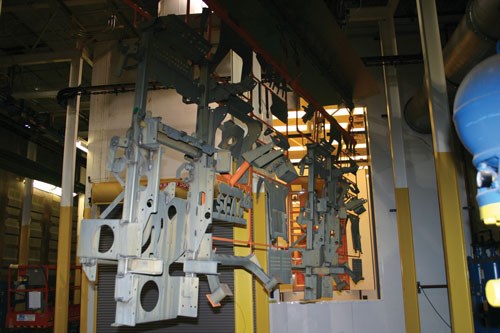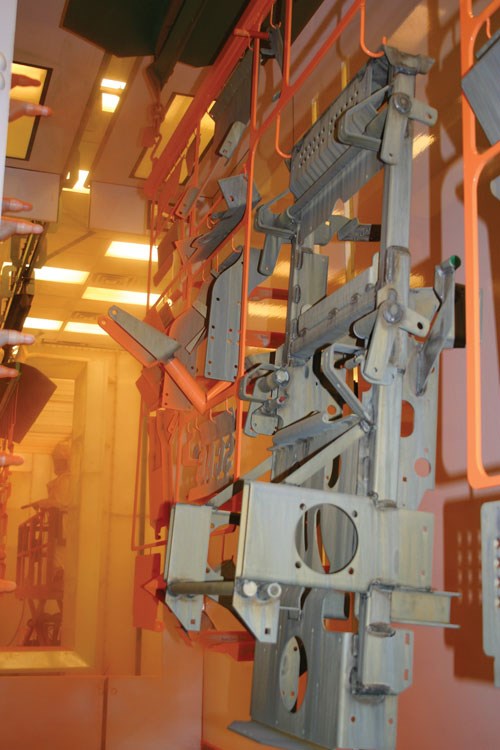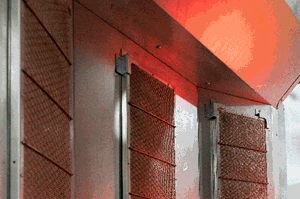When it comes to finishers getting maximum throughput and optimal first pass yield from their finishing departments, Metalcraft of Mayville, in Wisc. has quite a story to tell.
It’s a story of 300 percent throughput improvements, quadrupling labor productivity and 180 percent performance-to-manufacturing standards. A story of kitting product on the paint line so it can be delivered to the assembly line with maximum efficiency. A story of custom paint racks and jam-packed line density.
Tucked away on the north end of Mayville, a small Wisconsin city of 4,000 people, this contract fabricator, manufacturer and producer of Scag brand commercial lawn mowers and lawn maintenance equipment has quietly—though aggressively—embarked on a lean journey that would grab the attention of any finisher seeking to improve quality and reduce cost.
Walking the manufacturing floor and making it a point to greet each and every employee by name, Vice President of Operations Randy Gloede reflects on the journey, noting that at the outset the Metalcraft team recognized that the capacity constraint that was the paint coating department would be a key area of focus.
“We looked at how we could do a better job delivering to the voice of the customer,” Gloede says. “In the case of the paint line, our assembly line is the customer.”
Metalcraft began by breaking down the entire value stream to find waste in its system. The company uses a simple definition to identify waste.
“If a customer won’t pay for it, it’s officially waste,” Gloede says.
Any steps in its finishing process that didn’t directly add value to the product and thus the customer were attacked.
Less than a year ago the company delivered components to its assembly line in batches of parts, and the assembly line pulled these parts out of work-in-process inventory to be assembled into its lawn tractors. If a batch of parts didn’t flow off of the paint line before they were needed by the assembly department, the assembly line would have to be shut down, causing labor and production inefficiencies and disrupting employee work schedules.
So working backwards from the assembly line to the paint line, Metalcraft challenged itself to find a way for the paint line to deliver to the assembly line the exact quantity of parts needed to produce a single tractor at—or shortly before—the moment these parts were required.
To reach this goal, the paint line needed to deliver parts in kits, or the precise combination of individual component parts needed for one tractor. The solution was a “kit rack” capable of carrying the right combination of parts through the paint line. This rack is removed from the paint line and transferred on a cart to the assembly cell where the parts it holds can be assembled into the final product.
The benefits to the assembly line—inventory reductions, the elimination of line downs, delivering components to the exact point of use—are clear. But Metalcraft also focused keenly on reducing waste in the paint department. By engineering racking that maximizes line density and presents product to the paint line in a manner that optimizes yield, the paint department’s productivity has gone through the roof.
For example, a year ago the paint line required a crew of 11 people to load parts, unload parts and apply powder. At that time the line was capable of painting the components for one complete tractor every eight minutes. The company’s attention to line density and kitting changed that for the better.
“We now paint with five people on the paint line and paint an average of two complete tractors every eight minutes,” Gloede explains.
Further, since the company can no longer rely on excess batch inventory in the event of a paint line reject, optimizing yield of conforming and thus usable painted parts became paramount. Therefore, a significant part of the paint line transformation involved identifying common rejects, plotting them on a Pareto Chart and then identifying and resolving root causes.
All told, the project has generated phenomenal results. Remember the regular shut-downs incurred on the assembly line when it ran out of parts? The company has not had a single shut-down in 10 months.
Now that product is kitted when it arrives on the assembly line from the paint line, assemblers no longer have to waste valuable seconds and minutes seeking out the right part. Today an entire tractor can be manufactured in under six hours, and though 34 Scag Tiger Cat (just one of several products manufactured here) are currently built each day, there are only 28 such units in process at any given point in time. That creates meaningful reductions in work-in-process inventory.
Metalcraft’s improvements have drawn the attention of customers and suppliers alike. American Finishing Resources is a valued supplier of coatings removal services and fixture fabrication to Metalcraft. AFR’s Dave Garczynski was impressed with the transformation on the Metalcraft’s paint line.
“Efficiency improvements measured in hundreds of percents are nothing short of incredible,” he says. “If you had told us a year ago that the Metalcraft team could have implemented this degree of change I’m not sure anyone would have believed it … but they did it.”
The improvements don’t stop, however, at throughput and quality. By organizing work centers and simplifying operations the company has drastically improved in the area of safety as well.
“Our most important metric is safety,” Gloede says. “We have cut our DART rate (Days Away, Restrictions and Transfers) by 50 percent in the last year. This is the metric we’re most proud of.”
Progress will continue at Metalcraft, where the idea that lean success is not a destination but a journey is well recognized.
“It’s amazing how much has changed in 18 months,” Gloede reflects. “And there’s still so much we can improve.” n
Matt Kirchner is Chief Executive Officer of American Finishing Resources, which specializes in powder coating and paint removal from paint line rejects, hooks and fixture. He can be reached at 920-849-7738, ext. 21, or at mkirchner@afrnow.com.

















.jpg;maxWidth=300;quality=90)












